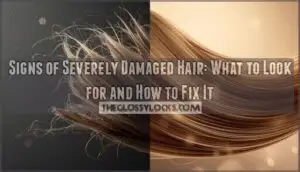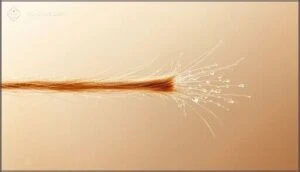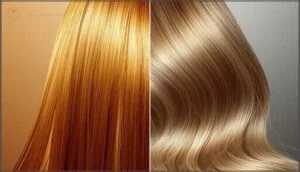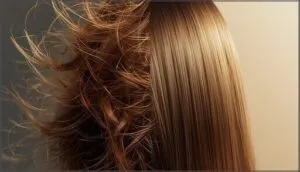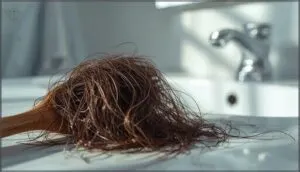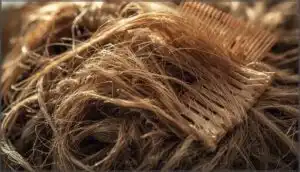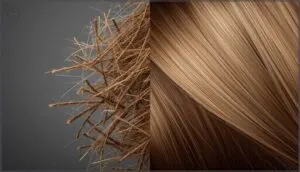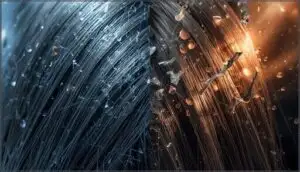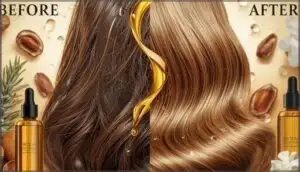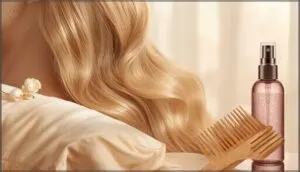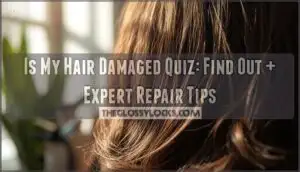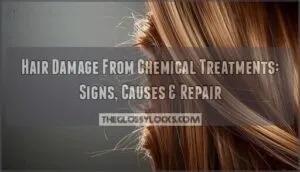This site is supported by our readers. We may earn a commission, at no cost to you, if you purchase through links.
You run your fingers through your hair and feel something unsettling. The strands catch and snag. They feel rough like frayed rope instead of smooth silk. Your hair has been screaming for help, but you might have missed the warning signs.
Damaged hair doesn’t happen overnight. It builds up from heat tools cranked too high, chemical treatments stacked too close together, and environmental stress your strands can’t defend against.
The good news? Once you recognize the signs of severely damaged hair, you can take action to reverse the harm and restore your hair’s strength. Understanding what healthy hair should feel like makes spotting the red flags much easier.
Table Of Contents
Key Takeaways
- Damaged hair shows clear warning signs like split ends, dullness, excessive breakage, constant tangling, and a rough, straw-like texture that signals your strands need immediate attention.
- Heat tools above 300°F, chemical treatments, tight hairstyles, and environmental stressors destroy your hair’s protein structure and strip moisture faster than your strands can recover naturally.
- Deep conditioning treatments, regular trims every 6-8 weeks, reduced heat exposure, and nourishing oils can repair severely damaged hair within 4-6 weeks for mild damage or 6-12 months for severe cases.
- Prevention through protective styling, heat protectants, and a consistent washing routine (2-3 times weekly with deep conditioning every 7-10 days) stops damage before it starts and keeps new growth healthy.
Key Signs of Severely Damaged Hair
Your hair tells you when something’s wrong. The signs of severe damage aren’t always obvious at first, but once you know what to look for, they’re hard to miss.
Here are the key indicators that your hair needs serious attention.
Split Ends and Breakage
Split ends—trichoptilosis in technical terms—happen when your hair fiber weakens and frays at the tip. You’ll notice breakage patterns that create shorter patches and uneven lengths. This fragile hair care challenge doubles your strand’s vulnerability from root to tip.
Heat tools and chemical treatments accelerate the damage. Regular trims every 6 to 8 weeks stop split end prevention issues before they travel upward. Understanding the importance of regular hair trimming schedules can help maintain healthy hair.
Dull, Dry, or Brassy Appearance
Beyond breakage, your hair may lose its natural glow and develop a dry, dull texture. When strands appear flat or lackluster, that’s dullness signaling moisture loss. Brassy tones often emerge in lightened hair—those unwanted yellow or orange hues mean your cuticles are compromised.
Hair moisture depletion leads to frizzy hair that tangles easily. Shine restoration and hair hydration through targeted dryness remedies and color correction can reverse these visible damage signs.
To prevent further damage, understanding the causes of color fade issues is essential for maintaining healthy-looking hair.
Frizz, Flyaways, and Unmanageable Texture
Frizz and flyaways are red flags that your hair’s protective layer is compromised. When 62% of women struggle with frizzy hair, you’re not alone. Damaged strands develop four times more surface friction, making texture repair essential.
Hair smoothening treatments and flyaway reduction techniques work by managing friction and restoring hydration. Friction management through targeted frizz control products helps tame unmanageable hair texture and prevents further hair breakage.
Excessive Hair Shedding and Thinning
When unmanageable texture escalates to visible hair loss, you’re seeing follicle-level damage. Normal hair shedding means 50-100 strands daily, but excessive hair tangling and breakage signal a deeper problem. Heat damage and chemical treatments weaken your scalp health and trigger accelerated hair thinning.
Watch for these shedding prevention warning signs:
- Clumps of hair in your brush daily
- Noticeable thinning patterns around your hairline
- More than 100 strands falling during washing
Understanding hair loss causes helps you take control before follicle repair becomes necessary.
Frequent Tangles and Knots
Persistent tangles reveal your cuticles are rough and raised. When damaged hair loses moisture, friction doubles between strands and knots form constantly. You’ll notice this especially from mid-lengths to ends.
Bleached or heat-styled hair tangles up to 50% more than healthy strands. If detangling requires serious force, your hair breakage and excessive tangling signal structural damage that needs immediate attention.
How Hair Damage Changes Texture and Appearance
When hair gets damaged, it doesn’t just look different—it feels different too. You might notice your hair has lost its bounce or smoothness, or that it breaks more easily than it used to.
Here are the main texture and appearance changes that show your hair needs some serious help.
Loss of Natural Shine and Smoothness
When your hair loses its natural shine, you’re looking at more than just a bad hair day. Severely damaged hair can lose up to 50% of its light reflectance, leaving you with a dry, dull texture that feels rough to the touch.
This happens when your cuticle layer lifts and thins, disrupting moisture balance and increasing hair porosity. Without proper cuticle repair and gloss enhancement, shine restoration becomes harder with each passing week.
Brittle or Straw-Like Feel
That stiff, brittle texture you’re feeling? It’s your hair crying out for help. When strands feel straw-like, you’re dealing with severe cuticle damage and lost moisture balance.
Heat tools above 125°C destroy hair fiber structure and protein bonds, spiking brittleness by 25%. Without protein repair and proper hydration, damaged hair loses elasticity fast.
Dry hair becomes fragile—breaking at the slightest tug.
Uneven or Shorter Hair Patches
Notice patches where your hair looks shorter or thinner than everywhere else? That’s often follicle damage or hair breakage catching up with you. Patchy alopecia and scalp conditions can create irregular hair loss patterns that disrupt regrowth cycles.
- Split ends climbing up the shaft create uneven lengths
- Thinning spots from tight braids or ponytails
- Broken pieces scattered through healthy sections
- Hair texture changes making some areas coarser
Identifying these patterns early helps prevent permanent follicle damage.
Common Causes of Severe Hair Damage
Your hair doesn’t just fall apart on its own. Damage happens when you expose it to things that strip away moisture and weaken its structure.
Let’s look at the most common culprits behind severe hair damage.
Heat Styling Tools and High Temperatures
Flat irons and blow dryers running above 300°F can literally cook your hair from the inside out. That’s when keratin proteins break down permanently and your strands lose their natural strength. You’ll see breakage and split ends multiply fast.
Heat tools above 300°F permanently destroy your hair’s keratin proteins, causing irreversible breakage and split ends
Always use a heat protectant spray and keep your tools below 350°F. Start with lower settings to prevent heat damage before it starts.
Chemical Treatments and Bleaching
Relaxers and bleach dismantle your hair’s natural structure from the inside. Chemical treatments break down the protective cuticle layer and weaken keratin bonds that hold each strand together. Studies show 61% of chemical relaxer users experience hair loss and 90% of women with hair breakage have a history of these treatments.
Watch for these warning signs of chemical damage:
- Brittle texture and increased split ends
- Scalp irritation with redness or itching
- Color fading faster than expected
Limiting chemical exposure protects your hair from permanent damage.
Over-Brushing or Tight Hairstyles
You might think brushing keeps your hair healthy, but doing it more than twice daily causes mechanical damage and cuticle wear. Tight ponytails and braids put constant tension on follicles, leading to traction alopecia—especially around your hairline and temples.
Up to 33% of women experience this follicle stress. Look for scalp irritation, split ends, and hair breakage as warning signs of these damaging habits.
Environmental Stressors and Sun Exposure
Your hair faces daily battles you can’t always see. UV damage breaks down proteins in your hair shaft—studies show UV exposure above 5 J/cm² destroys amino acids that keep strands strong. Air pollution drops growth proteins by measurable amounts. Heat exposure from summer sun strips moisture faster than any blow dryer.
Protect your hair with UV damage shields, antioxidant treatments, and consistent sun protection to fight these environmental stressors.
Repairing Severely Damaged Hair
Once your hair is damaged, it won’t heal on its own. You need to take action to restore moisture, strength, and shine.
Here’s what actually works to bring damaged hair back to life.
Deep Conditioning Treatments and Hair Masks
Deep conditioning treatments and hair masks deliver powerful hair repair by penetrating the shaft to restore moisture and rebuild weakened bonds. Your damaged hair needs this intensive care to bounce back from the stress it’s been through.
Here’s how to make the most of these treatments:
- Choose protein-based masks to rebuild your hair’s keratin framework and boost strength
- Look for hydrating mask ingredients like natural oils and glycerin that lock in hair moisture and hydration
- Apply weekly for consistent results – severely damaged hair may benefit from twice-weekly sessions
- Leave treatments on for 5 minutes to overnight depending on your hair’s condition and the product formula
These deep conditioning treatments smooth your cuticle and create a protective barrier against environmental damage. You’ll notice softer texture, better definition, and way less frizz. The hair mask benefits add up over time – your strands become more manageable and resilient with regular use.
Just watch out for overuse on fine hair. Too much conditioning can weigh you down with product buildup. Stick to the treatment frequency that matches your hair type and damage level.
Reducing Heat and Chemical Exposure
While masks help, you need to cut the source of the problem. Using heat styling tools more than twice a week multiplies your damage by 22 times.
Lower your flat iron to 150°C instead of 200°C and you’ll reduce breakage by up to 70%.
Space out chemical treatments to twice yearly – your hair can recover its strength in just three to six months.
Regular Trims for Split End Control
Every six to eight weeks, schedule a trim to stop split ends from climbing up your hair shaft and causing more breakage. Regular trims cut damaged hair by up to 50%.
You’ll notice smoother texture and better manageability right away. Your hair will look fuller and healthier, which boosts confidence.
Trims don’t speed growth but they prevent breakage so you keep more length.
Hydration and Nourishing Hair Oils
On damp hair, apply oils like coconut or argan to lock in hair hydration through sealing effects. Oil penetration repairs dry hair by reducing protein loss and restoring hair elasticity.
Try hot oil treatments for 20-30 minutes to boost hair moisture and nourishment. Use a dime-sized amount from ends upward to avoid scalp buildup and keep strands manageable.
Preventing Further Hair Damage
Once you’ve started repairing your hair, the next step is making sure the damage doesn’t come back. Prevention is about building habits that protect your strands from the stress they face every day.
Here are three key strategies to keep your hair healthy and strong moving forward.
Protective Styling Techniques
Protective styling gives your hair a break from daily manipulation and heat styling tools. Braid maintenance and style versatility through buns or weaves help lock in moisture and reduce breakage. Hair wrapping at night with silk or satin minimizes friction.
Focus on scalp care while styled and practice gentle removal to avoid shedding. These hair care techniques shield your strands from environmental stressors and constant handling.
Using Heat Protectants and Filters
Heat protectant sprays act as thermal shielding between your strands and heat styling tools. They reduce moisture loss by up to 44% and markedly lower breakage rates. Apply before every heat session to preserve hair insulation and strength.
Consider these protective steps:
- Choose silicone-based formulas for maximum heat damage protection
- Install shower filters to remove minerals causing dryness
- Reapply heat protectant after each wash
- Limit styling temperatures below 200°C
Establishing a Consistent Hair Care Routine
Your hair thrives on rhythm. Wash 2–3 times weekly to protect natural oils while keeping strands clean. Schedule deep conditioning every 7–10 days and protein treatments every 4–6 weeks to maintain hair moisture and protein balance. Add monthly scalp exfoliation to your hair care routine. Rotate your hair care products based on hair typing and seasonal needs. Consistency transforms damaged hair into healthy hair.
Frequently Asked Questions (FAQs)
Can damaged hair grow back healthy naturally?
Yes, but only from the roots. New strands emerge healthy from your follicles during the hair regrowth cycle.
Damaged hair shafts can’t repair themselves—you’ll need natural repair methods and regular trims while waiting.
How long does hair repair actually take?
Like watching a plant heal after a storm, hair repair timelines vary. Mild damage usually improves within 4-6 weeks.
Severe breakage from chemicals or heat often requires 6-12 months, depending on damage severity and treatment consistency.
Does diet affect damaged hair recovery speed?
Absolutely. Protein intake and micronutrient role directly influence hair growth speed. Nutrient deficiencies slow recovery, while caloric balance and dietary patterns restore hair health. Proper hair nutrition accelerates repair and strengthens damaged strands markedly.
Are salon treatments better than home remedies?
Professional treatments pack a punch when your strands are crying for help. Salon benefits include expert hair repair products and tailored restorative treatment plans.
But consistent hair care treatments at home maintain results between visits.
When is hair too damaged to save?
Hair becomes too damaged to save when it shows irreversible damage signs like constant breakage despite treatments, massive thinning, or straw-like texture. At that point, cutting necessity and professional intervention offer the only real solution.
Conclusion
Your hair tells a story written in split ends and brittle strands. When you ignore the signs of severely damaged hair, that story ends with scissors cutting away what you wanted to keep.
But when you listen—really listen—to what your hair needs, you become the author of a different ending. Deep conditioning replaces roughness with strength. Heat protectants shield instead of scorch.
The power to rewrite your hair’s future sits in your hands right now.
- https://www.reddit.com/r/HaircareScience/comments/kcaomf/protecting_hair_cuticles_from_damage/
- https://www.k18hair.com/blogs/consumer/what-really-causes-split-ends?srsltid=AfmBOooEnikfjUKSxRWLhgsAhLBepaZLK6bwWuGRSJpRZ17nime5PcMU
- https://willowbrookvetclinic.com/all-about-shedding-is-my-pet-shedding-too-much/
- https://pubmed.ncbi.nlm.nih.gov/
- https://www.cdc.gov/hygiene/about/hair-and-scalp-hygiene.html

